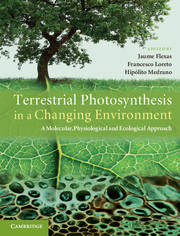 Terrestrial Photosynthesis in a Changing Environment
Terrestrial Photosynthesis in a Changing Environment Book contents
- Frontmatter
- Contents
- List of contributors
- Preface
- Acknowledgements
- List of abbreviations
- 1 Terrestrial photosynthesis in a changing environment
- Part I Photosynthesis
- Part II Measuring photosynthesis
- Part III Photosynthetic response to single environmental factors
- Part IV Photosynthesis in time
- Part V Photosynthesis in space
- 26 Whole-plant photosynthesis: potentials, limitations and physiological and structural controls
- 27 Ecophysiology of photosynthesis in the tropics
- 28 Ecophysiology of photosynthesis in desert ecosystems
- 29 Ecophysiology of photosynthesis in semi-arid environments
- 30 Ecophysiology of photosynthesis in temperate forests
- 31 Ecophysiology of photosynthesis in boreal, arctic and alpine ecosystems
- 32 Crop photosynthesis
- Part VI Photosynthesis in a global context
- References
- Index
30 - Ecophysiology of photosynthesis in temperate forests
Published online by Cambridge University Press: 05 March 2013
- Frontmatter
- Contents
- List of contributors
- Preface
- Acknowledgements
- List of abbreviations
- 1 Terrestrial photosynthesis in a changing environment
- Part I Photosynthesis
- Part II Measuring photosynthesis
- Part III Photosynthetic response to single environmental factors
- Part IV Photosynthesis in time
- Part V Photosynthesis in space
- 26 Whole-plant photosynthesis: potentials, limitations and physiological and structural controls
- 27 Ecophysiology of photosynthesis in the tropics
- 28 Ecophysiology of photosynthesis in desert ecosystems
- 29 Ecophysiology of photosynthesis in semi-arid environments
- 30 Ecophysiology of photosynthesis in temperate forests
- 31 Ecophysiology of photosynthesis in boreal, arctic and alpine ecosystems
- 32 Crop photosynthesis
- Part VI Photosynthesis in a global context
- References
- Index
Summary
The Temperate-Forest Environment
The temperate zone is characterised by pronounced seasonality with temperatures of the warmest month generally higher than 10°C and temperatures of the coldest month generally between –10 and 10°C (Köppen, 1936; Russell, 1931). Temperature is arguably the most important climatic variable in temperate forests. Temperatures during warm and cold periods are strongly variable within the temperate-forest biome, depending on continentality, latitude and topography (Fig. 30.1). Total precipitation is generally greater than 50–75 cm year–1 and is more uniformly distributed over the year than in arid (Chapter 28) and in semi-arid (including Mediterranean ecosystems) (Chapter 29) habitats. The annual input of solar radiation is between 2500–6000 MJ m–2, varying with site latitude, cloudiness and topography (Jarvis and Leverenz, 1983).
Temperate forests are dominated by deciduous trees in oceanic and continental areas of the Northern hemisphere, while evergreens dominate in warmer locations and in the Southern hemisphere. In the edges of temperate biome, mixed forest may appear. Thus, on the cold border the transition to steppes is characterised by open conifer or deciduous forests, while there are mixed conifer-deciduous woodlands in the transition to the boreal biome. In the warm border, the transition is characterised by subtropical evergreen forests in humid locations and by the presence of deciduous Mediterranean oaks in more arid sites.
- Type
- Chapter
- Information
- Terrestrial Photosynthesis in a Changing EnvironmentA Molecular, Physiological, and Ecological Approach, pp. 465 - 487Publisher: Cambridge University PressPrint publication year: 2012
- 5
- Cited by
